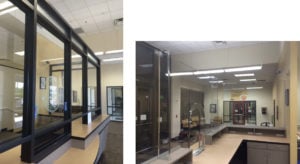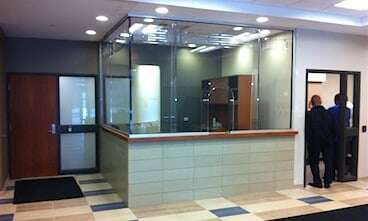According to the FBI, roughly one-third of our nation’s 1.1 million local law enforcement offices are non-sworn staff. These are records clerks and desk staff, radio dispatchers, correctional officers, jailers, and so on.
Non-sworn staff usually don’t carry sidearms or have arrest power. Nonetheless, they face much of the same on-the-job abuse as sworn officers.
Local police forces are increasingly reliant on non-sworn staff: An analysis by the the U.S. Department of Justice’s Bureau of Justice Statistics found that, over the course of the decade ending 2012, law enforcement staffing increased nationwide by 38 percent. Although there was just a 31 percent increase in sworn staff, non-sworn staff swelled by 55 percent.
That’s more than 325,000 law officers, vital to daily law enforcement operations, who are unarmed and in harm’s way.

Increasingly Deadly Attacks in and Near Police Stations
The public generally under-appreciate the burden of risk shouldered by non-sworn staff. Total Security Solutions sales manager Bob George has worked with many police stations on their customized bullet proof barriers: “It’s scary, sometimes, the kinds of situations that these people are in,” Bob says. “Officers are acutely aware of that. Even in rural areas, I hear guys say, ‘You know, we don’t have much happen out here, but we have our girl working out here in reception, and we want to make sure it’s safe.’”
Consider this harrowing 2011 incident in Detroit: 38-year-old Lamar Moore, armed with a shotgun, burst into the 6th precinct and opened fire. He injured four officers and endangered more than a dozen individuals, including sworn officers, non-sworn staff, and citizens:
(The unedited security footage, narrated by then Assistant Police Chief Chester Logan, starts at 2:27.)
Following a 2009 incident at a Florida police station, Major Craig Richards noted: ”The world is becoming more violent and police are becoming more of a target. At our front desk are volunteers, civilians, light duty officers—people who are not used to being in confrontations and are not armed. Why not take steps to protect your people?”
Total Security Solutions CEO Jim Richards asks himself the same question, especially after incidents like these. “I’m often surprised by how many police stations in this country lack bullet resistant glass and building materials,” Jim says. “That’s unfortunate. A big part of that, I think, is misconceptions about how fully bullet resistant systems have evolved.”
Modern Police Station Bullet Resistant Barriers
Jim has found—especially in recent years—that law enforcement agencies are very concerned about the perception that they are cutting themselves off from the population they serve.
“Law enforcement want their stations to feel welcoming. Actually, given what politics right now are, they need for their stations to feel inviting and open. They are working really, really hard to make make those personal connections with citizens in their communities, so they can do their jobs. But because we see so much cheap bullet-proofing out there—slapped up in liquor stores and fast food places and whatever—many people still have this idea in their head that the best you can do is dingy, scratched up tempered glass two inches thick with a drawer and an awful intercom.”

Before (left) and after (right) pictures of TSS’s retrofit of the Travis County Sheriff’s Office in Austin, Texas. Note the improved sight-lines and security. TSS eliminated thick framing elements and replaced open speak-holes and pass-thrus with natural-voice arch windows and secure inset passing trays.
“There’s this sense,” Jim continues, “that the bullet proof barrier is automatically a barrier to communication and connection. With modern designs and materials, that’s really not the case anymore. When bullet resistant systems are designed and installed correctly, they aren’t the first things you notice when you walk in. They blend in and fade into the background. Travis County is a really good example of that. The non-sworn staff look and feel much more accessible, even though they are actually much more securely separated from a possible threat.”
Designing Custom Bulletproof Barriers for Your Station and Budget
But Jim doesn’t think misconceptions about bullet resistant barrier design are the major factor preventing police stations from upgrading—even when that’s what gets said out loud.
“There are very legitimate concerns about keeping communication clear and keeping the lobby from looking like the lock-up. But I think a lot of this comes back to budgets,” Jim says. “Budgets are tight, there’s a lot of bad feelings floating around out there, and law enforcement gets spread very thin. Bulletproof security just really isn’t on the table for many locales until there’s an incident. That’s a recipe for tragedy.”
TSS has done countless custom law enforcement installations and retrofits. They’re ready to put in the time to design a barrier that fits a specific station’s needs and budget.

